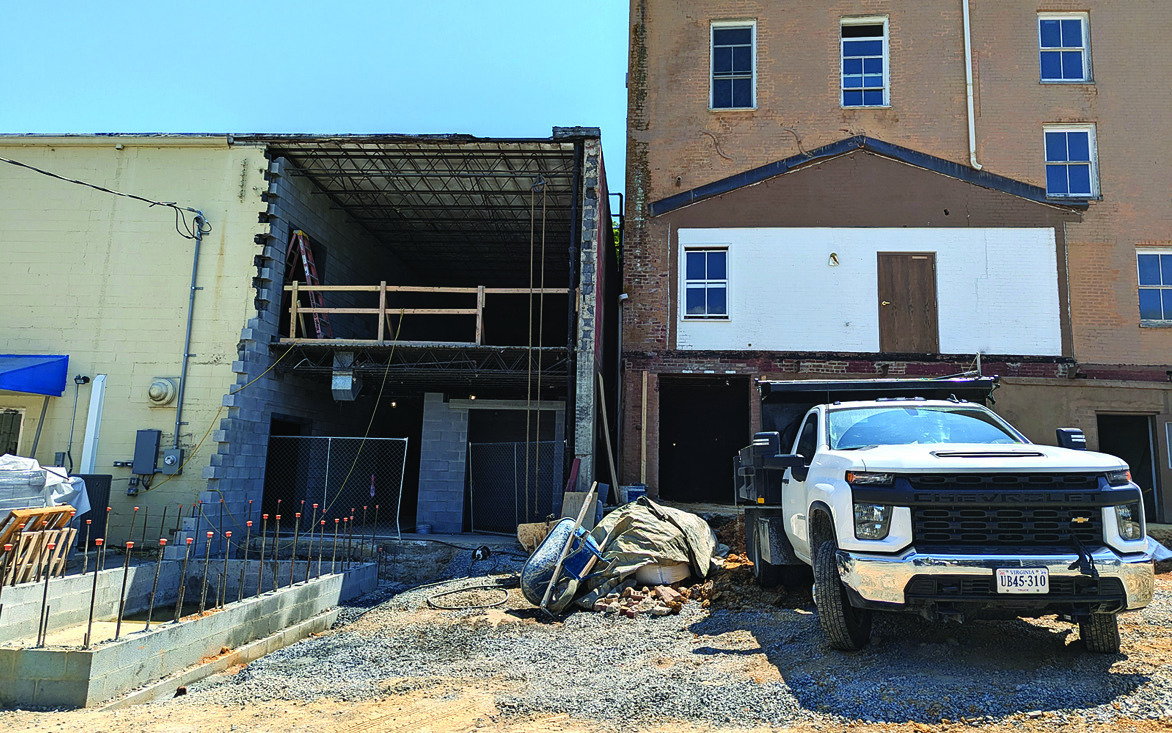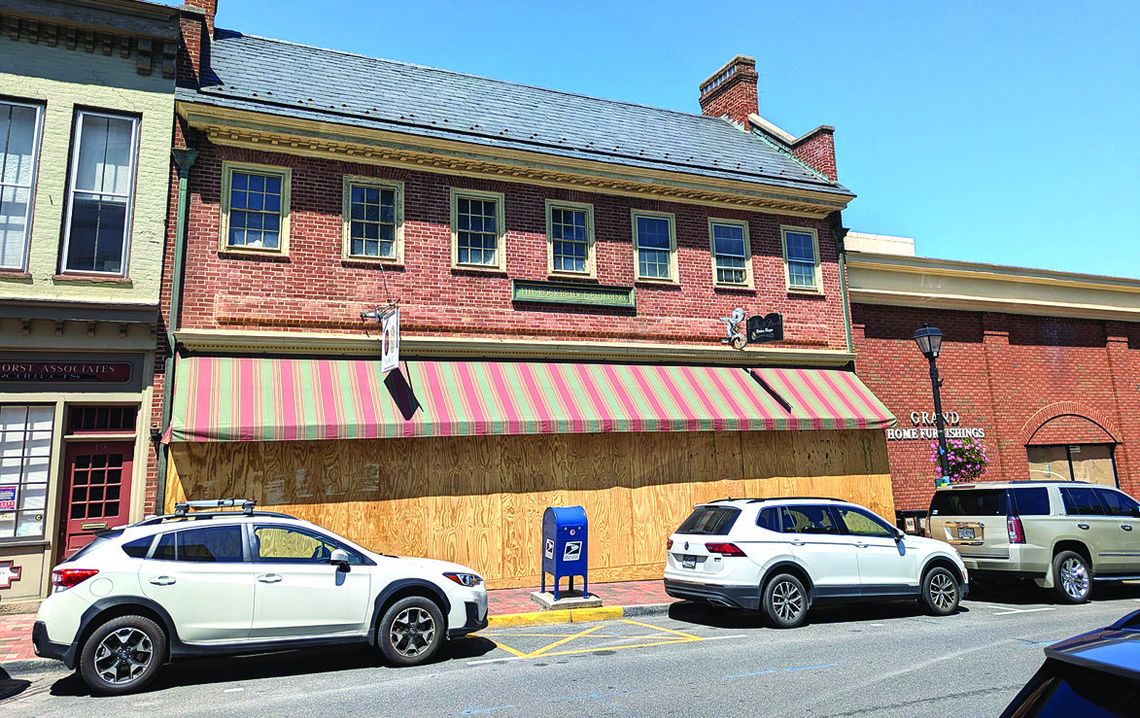Retail, W&L Office Space Planned For Downtown
A request for a conditional use permit to lease downtown office space for use by Washington and Lee University was tabled Thursday by the Lexington Planning Commission.
John Adamson of Rockbridge Partners LLC is seeking to lease space to W&L on three floors of the historic Rockbridge Building at 9-17 S. Main St. On the main level, two storefront spaces that contain 1,800 square feet each and face Main Street would be used for retail outlets, under Adamson’s plans.
This CUP application, along with another one from Adamson for a renewal of leased uses by W&L in the former Rockbridge County courthouse at 2 S. Main St., prompted a lengthy discussion about “W&L creep” into downtown as well as how to best restore and maintain historic structures in the downtown business district.
“We are in the process of completing a pretty comprehensive renovation of the Rockbridge Building – making a substantial investment in the historic fabric in Lexingon’s downtown,” Adamson told the Commission. “[The building] will be completely updated with all new lifesaving systems, including sprinklers, electrical HVAC, plumbing and lighting.”
He noted that the Rockbridge Building, which formerly housed McCrum’s Drugstore, dates to the mid-1850s. He said he is also undertaking major renovations to an adjacent structure he owns, formerly Grand Home Furnishings, that once held Adair Hutton department store. He said a “spine” is being created between the two buildings that will contain an elevator and a corridor that will have access to both Main Street and the McCrum’s parking lot behind the buildings.
A below-ground level of the Rockbridge Building would be utilized for W&L office space but, he said, could also be used as a meeting space, or an “assembly” area, for university gatherings, such as the W&L mock political convention held every four years. Although the upstairs level would be used as office space initially, he pointed out that it “could easily be converted” to residential space at some point in the future.
“One of the important things I think we do for these buildings is the installation of complete sprinkler systems,” said Adamson. “So it not only protects the building we’re working on but it protects the buildings on either side or the other side of it. We believe a safe downtown is good for everyone. It helps preserve these historic buildings for future generations.”
During their discussions, Commission members alluded to concerns about “W&L creep into downtown” that had been expressed to them by citizens. A letter from a former City Council member that was critical of Adamson’s plans was read into the record. Three citizens who spoke at public hearings for the two CUP applications expressed support for the plans, saying the considerable investments Adamson is making in these historic buildings would assure the continued viability of downtown.
“We’re just very pleased that we’re having an historic building restored and brought up to current uses,” said Rebecca Logan, executive director of Main Street Lexington. “We’re very glad that we have two new retail spaces that will have modern plumbing, modern electricity. The building itself is [to be] ADA compliant as well as [have] fire suppression. The upper stories were always offices. It was a crazy, steep stairway to the offices. The fact that all of this is going to be much more accessible and easier to use, we’re just very happy. … We’re pleased that the building is [being] beautifully restored through historic preservation.”
Previously, with much of the space in the building’s nonfronting areas vacant, “it was just kind of a black hole on Main Street,” observed Jeff Hughes of Sugar Maple Trading Company, a downtown business. Having all of the space occupied, he continued, “is a big plus … Those are the things that put pedestrians on Main Street … this will bring in people, new customers who otherwise wouldn’t be downtown or on Main Street.”
Skip Ravenhorst, a long-time Lexington architect who has office space in the Rockbridge Building, praised Adamson’s investment in downtown. “These things don’t come cheap. It’s been mentioned that when it’s done it will be a stateof- the-art, safe, fire-resistant structure that’s good for the whole block, for the whole city.” W&L, he said, is able to afford to pay the rent for the office space to make the restoration of the historic building possible.
Ravenhorst said he can understand the sentiment of not wanting to see W&L “gobble up all of the real estate but I don’t think that’s what’s happening here. I think they’re contributing to the community by paying some reasonable rents so [Adamson] can afford to house these shops and other entities in there. So, I would strongly encourage you to approve what he’s requesting.”
In a letter that was read during one of the public hearings, former City Council member Patrick Rhamey urged the Commission to reject both CUP applications. He said he thought the city was getting away from granting such CUPs in the downtown area.
“From a planning perspective, this is bad practice,” wrote Rhamey. “We specifically did not include the use by right in C1 in hopes of limiting the creep of our cherished billionaire institutions, such that we’re able, in their methodical takeover of the town. Making an exception because Adamson, W&L, or any other very important entity asks is deeply inappropriate and a betrayal of the public trust.”
According to Rhamey, “Offices and meeting spaces may seem an innocuous use, but aside from being less square footage for productive commercial endeavors (for which the city receives revenue), it’s also creeping into typically residential spaces above downtown businesses. Residential space is not only essential to dealing with our local housing shortage but also to the vibrancy of downtown. When people work, but don’t live, in downtown areas, be they big or small, it destroys communities.”
Leslie Straughan, City Council’s liaison on the Commission, said she would have concerns about W&L gaining more office space in downtown if there was a shortage of it. She said she knows differently from having gone through the search for temporary space for City Hall during its upcoming renovations. “We aren’t close to zero vacancy,” she said. “In two years, the Department of Social Services is going to move out of downtown so we will have a lot of office space available downtown. So, I don’t see that this use will displace anybody.”
The first vote the Commission took – on the renewal of the CUP application for W&L’s continued use of the former county courthouse at 2 S. Main St. – was 5-0 in favor of approving it. The motion by John Driscoll, seconded by Mary Stuart Harlow, stated that the courtroom or vault room could continue to be used for public assembly purposes in perpetuity. The second part of the motion allows, for a period of 15 years, for the remainder of the building to be utilized for administrative facilities related to W&L’s educational purposes.
As for the second CUP application, a couple of Commission members said they needed more time to study the various issues the request raises.
“When I hear from people who call me up … one of the main concerns is W&L expansion, W&L expansion, W&L expansion,” said Driscoll. “And yet, on the other hand we can say, in some cases, it’s fine, it makes sense because, otherwise, this particular building would not be improved because only W&L can come up with the rents to pay back the expenses.” He said he needed more time and information – specifically, drawings of the plans – to make up his mind on whether or not to approve the application.
“People are concerned about W&L creep,” said Commission chair Shannon Spencer. “I think it’s fair to say that we would like a little more time that we could look at those plans.”
Adamson responded that it was certainly the Commission’s prerogative to ask for more time but the information being sought was provided to the city’s department with the CUP application quite some time ago. To a request from Spencer, he said he would provide members with digital copies of the documents.
Straughan, saying she would be unable to attend the Commission’s next meeting on Sept. 11, said she favored approval of the CUP.
“This project meets several goals of our comprehensive plan and our strategic plan,” she said. “It’s significantly expanding the tax base. It’s a significant improvement. It may be W&L in that space but John owns it and has full taxes paid on it. … [W&L’s presence in downtown] gets the students and the faculty and the parents off campus and into town. I eat downtown four days a week and I see the folks in the buildings out eating, rather than eating on campus, and shopping downtown. So, it does make a difference to be located in town versus campus. It’s only two blocks but it makes a difference.”
After the discussion had ended, Harlow made a motion to table the CUP request until the next meeting on Sept. 11. Driscoll seconded the motion, which passed on a 4-1 vote, over Straughan’s dissent.

RENOVATION work is underway on both the southern part of the former Grand’s building (at left) and the Rockbridge Building (at right) as seen in this photo taken at the rear of the buildings last week. (Darryl Woodson photos)





